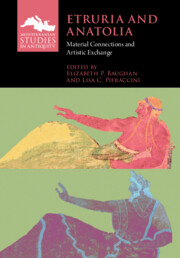Book contents
- Etruria and Anatolia
- Mediterranean Studies in Antiquity
- Etruria and Anatolia
- Copyright page
- Epigraph
- Contents
- Maps and Figures
- Contributors
- Preface
- Acknowledgments
- Notes on Abbreviations and Spelling
- Introduction
- Part I Broadening Perspectives
- Part II Interpretive Frameworks
- Part III Technology and Mobility
- Part IV Shared Practices
- Part V Shared and Distinct Iconographies
- Part VI Shared Forms, Distinct Functions
- 15 Forms and Functions of Beds and Couches in Etruscan and Anatolian Tombs
- 16 Female Assembly on Archaic Etruscan and Anatolian Funerary Monuments
- 17 Anatolian Fashion in Etruscan Clothing
- 18 Male Necklaces in the East and West
- Index
- References
18 - Male Necklaces in the East and West
from Part VI - Shared Forms, Distinct Functions
Published online by Cambridge University Press: 02 March 2023
- Etruria and Anatolia
- Mediterranean Studies in Antiquity
- Etruria and Anatolia
- Copyright page
- Epigraph
- Contents
- Maps and Figures
- Contributors
- Preface
- Acknowledgments
- Notes on Abbreviations and Spelling
- Introduction
- Part I Broadening Perspectives
- Part II Interpretive Frameworks
- Part III Technology and Mobility
- Part IV Shared Practices
- Part V Shared and Distinct Iconographies
- Part VI Shared Forms, Distinct Functions
- 15 Forms and Functions of Beds and Couches in Etruscan and Anatolian Tombs
- 16 Female Assembly on Archaic Etruscan and Anatolian Funerary Monuments
- 17 Anatolian Fashion in Etruscan Clothing
- 18 Male Necklaces in the East and West
- Index
- References
Summary
Luxurious dress and jewelry were important in public self-representation in Perso-Anatolian and Etruscan cultures. What distinguishes jewelry use in these societies is that jewelry was equally significant for elite males as it was for females. In fact, most of the visual evidence for jewelry in the East comes from ornaments worn by soldiers, court officials, and kings. Persian, Anatolian, and Lydian women are rarely represented in the surviving art, making it unusually difficult to reconstruct the jewelry styles and types they favored. Etruscan men, too, showed themselves with rings, bracelets and armbands, necklaces, and earrings. This chapter examines the male adoption of jewelry and explores the meanings of personal ornaments in both cultures.
- Type
- Chapter
- Information
- Etruria and AnatoliaMaterial Connections and Artistic Exchange, pp. 318 - 332Publisher: Cambridge University PressPrint publication year: 2023

